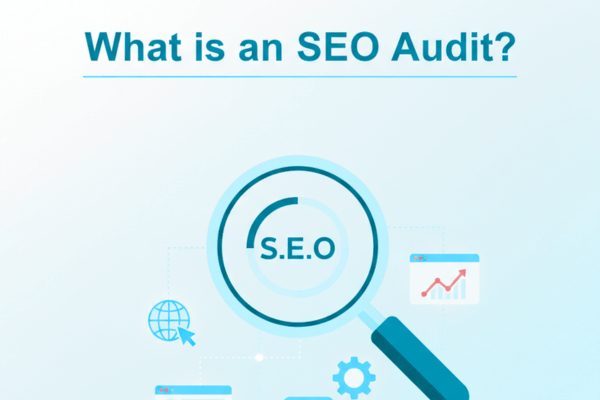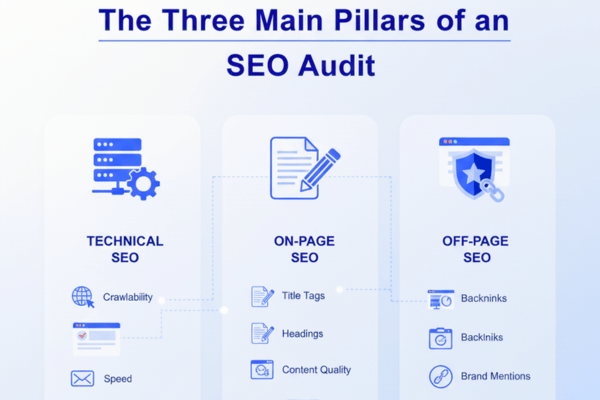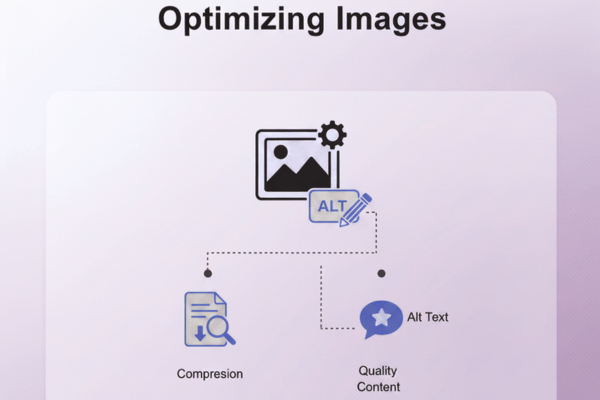Think about your website as a vehicle. A brand new car is absolutely great, but as it ages, it needs a checkup to ensure that everything is running just fine. An SEO audit just does the same checkup for a website – a thorough health check-up for your website. It is the process of intimately peeking into the different areas of the site to assess what parts are functioning well and what are needed to be fixed to help the overall performance of the site in the results of search engines like Google.
One of the functions of an SEO Audits to Improve Your Site is straightforward: make the website more visible, more user-friendly, and, in the best-case scenario, be placed on the first page of the search results. You can keep the game of SEO-leadership kind by applying SEO audits on your website.
Why Are SEO Audits So Important?

“What really urges my site to get an audit, my site looks good to me,” may be your next thought. The internet is a crowded place, and search engines are constantly changing how they rank websites. Let me tell you how an SEO audit helps you:
Find Hidden Problems: An SEO audit can expose too long loading times or outdated links, and you may not have even thought of such problems happening.
Help the Website Owner to Bring in More Visitors: SEO Audits to Improve Your Site will assist you in achieving your goals by making your site easier for users, and so that more durational visits will be encouraged.
Increase the Website Traffic and Ranking: An SEO Audits to Improve Your Site along with issue fixing and website optimization can help make your website more valuable in the eyes of search engines and hence, higher rankings, and more organic traffic will be the result.
Keep you Ahead of your Rivals: Through the SEO Audits to Improve Your Site, you can with ease discover what strategies your competitors are applying to have success, thus you can draw inspiration from them and even take a step further.
The Three Main Pillars of an SEO Audits to Improve Your Site

While performing an SEO Audits to Improve Your Site, dividing the task into three segments is more profitable. Such are the three legs of a stool—if one is weak, the whole thing can fall over.
Technical SEO Audit: The Foundation
The technical SSEO Audits to Improve Your Site is focused on the “behind-the-scenes” stuff that communicates to the engines how to access your site. It is the groundwork that needs to be laid before anything else.
Checking Site Crawlability and Indexability
This is the most crucial part to be done. If Google cannot find or “understand” your pages, they will not display in search results. Take a library for instance. The books (pages) in your website need to be properly cataloged so the librarian (Google’s crawler) can shelve them.
What to check: Use a tool like Google Search Console to see if any pages are being blocked or have errors.
Simple fix: Make sure your robots.txt file and sitemap are set up correctly.
Making Your Site Mobile-Friendly
Most people use their phones to browse the internet. Google knows this and is why it uses the “mobile-first” approach for ranking. If your site is not mobile-friendly then you are missing out.
What to check: Use Google’s Mobile-Friendly Test tool to see how your site looks on a mobile device.
Simple fix: Use a responsive design that automatically adjusts to any screen size.
Improving Page Speed
No one likes a slow website. If a page takes too long to load, people will get impatient and leave. These search engines, however, might lower you rank if they notice this behavior.
What to check: Use a free tool like Google PageSpeed Insights to see your site’s speed score.
Simple fix: Compress images, use a good web hosting service, and limit heavy elements like complex animations.
On-Page SEO Audit: Optimizing Your Content
The emphasis of this part of the SEO Audits to Improve Your Site is on the pages’ content, and it entails ensuring that your text, images, and other on-page elements are suitably arranged for your targeted keywords.
Reviewing Title Tags and Meta Descriptions
They are quite similar to headlines and summaries from a newspaper article. The results of a web search show them, and they let people know what the page is about.
What to check: Confirm that each page not only has a title tag and meta description but that they are also unique, descriptive (title under 60 characters, description under 160 characters), and include the main keyword of your page.
Simple fix: Create attractive titles and descriptions that make users interested to click on them.
Using Headings (H1, H2, H3) Correctly
Headings serve as the chapters and sub-chapters of a book. They are at the top of the index that tells people what the contents of your page are and make it easy to scan. An H1 is your main heading, and H2s and H3s allow you to divide the content into smaller parts.
What to check: Each page should have a single H1 tag, and this main heading should be your primary keyword. Besides that, content should be structured with the use of H2 and H3 tags in a logical manner.
Simple fix: Break up your page with headings and subheadings to make it more readable.
Crafting Great Content
Content is still the most important thing! Your pages must address the needs of your users. In other words, you can do this by writing high-quality, unique, and relevant content in the form of questions and answers.
What to check: Search for thin or duplicate content. How does your content compare to your competitors’?
Simple fix: Rejuvenate your old blog posts, and add new info and create content that is helpful to others.
Optimizing Images

It’s true that images may enhance the appearance of your site, yet they can also cause it to load at a slower speed. Therefore, both for you and the search engines, you have to optimize them.
What to check: Are your images compressed, and do they have “alt text” (a short description) that contains the relevant keywords?
Simple fix: Compress images using a tool and write a descriptive alt text for every image.
Off-Page SEO Audit: Building Authority
Off-page SEO refers to those activities that are external to your website. The major contributor to success here is backlinks, which are essentially links from other websites leading to your site.
Analyzing Your Backlinks
A backlink should be thought of as a sign of support. In the case when a well-known website links to you, it informs search engines that your website is credible and authoritative.
What to check: Employ a backlink analysis tool to get the data of websites that are linking to you. Identify links of good quality and remove any that are considered spammy, which can harm your rank.
Simple fix: Concentrate on producing excellent content that others would naturally want to link to.
Checking for Brand Mentions
Even if a website does not provide a link to you, a reference to your brand can still be helpful. It indicates that your brand is being talked about online.
What to check: Look for cases in which your brand is mentioned on social media, news, blogs, forums, etc.
Simple fix: Connect with individuals that mention your brand and, if it fits the situation, request if they would put a link.
Tools to Help You with Your SEO Audit
You don’t have to do all of this manually! There are many tools, some of which are free, that can make your life much easier when you are doing an SEO audit to improve your site.
Google Search Console: Your direct connection to Google. It lets you know about technical issues, and how well your site is doing.
Google Analytics: Measures the quantity of visits to your SEO Audits to Improve Your Site and the actions of users.
Screaming Frog: One of the top tools that scans the website for technical problems such as broken links and duplicated content.
Ahrefs or Semrush: The few among the many SEO platforms that combine the features of SEO audits with great site audit tools(page offers free trials or tools).
Google PageSpeed Insights: Tests your site’s speed and suggests steps to take to solve the problem.
Putting It All Together: A Simple SEO Audit Checklist
A summary of the checklist is given below to assist you:
Technical SEO: Check Google Search Console for any errors. Make sure your website is mobile-friendly and that it loads with speed.
On-Page SEO: Check your title tags, meta descriptions, and main point headings are right. Check your content for quality and its uniqueness. All your images should be optimized.
Off-Page SEO: Look at your good and bad backlinks and get rid of any that are toxic. Reach out high-quality link-building strategies for backlinks of good quality.
Conclusion
Doing SEO audits to raise your site performance aren’t a once-in-a-lifetime event. The online world is continuously changing; hence, you are advised to do a thorough audit a couple of times per year. Consider it as a form of guidance means. An SEO Audits to Improve Your Site lets you know where your website is, what its destination is, and which route is the best to take. You will in no time have a better functioning site by using these very simple steps being a part of your everyday routine.
FAQS
Q. What is an SEO audit and why should I do one?
Ans. An SEO audit is basically an examination of the website to check its overall health. It is a check for what is working and what is not, thus helping to get rid of the problems that are holding your site back. As a result of frequent SEO audits, the performance of your site can go up, you will get more visitors, and you can also have better rankings on Google.
Q. How often should I conduct an SEO audit?
Ans. Ideally, you should perform a complete SEO audit once or twice a year at most. However, if you have done big change on your website (be it a redesign or new content strategy), then you should conduct a post-change check or a quick audit to make sure that everything is working well.
Q. Is an SEO audit something a beginner can do on their own?
Ans. Yes, a beginner can do a lot on his/her own but not to the same extent as a professional would do. Basically, you can do SEO simple tasks like finding broken links, making sure your site looks fine on a mobile phone, and providing good title tags. Performance-wise this could mean a big leap for your site. Free tools will make things easier for you.
Q. What are the most important things to check in an SEO audit?
Ans. Concentrate on three major things: Technical, On-Page, and Off-Page SEO.
Technical: Make sure Google can find and understand your pages easily. Check your site speed and that it works well on phones.
On-Page: Analyze your content. Are your titles and headings recognizable? Is your content great?
Off-Page: Check your backlinks. Are they from strong, reliable sources?Q. Will conducting an SEO audit guarantee I rank on the first page?
Ans. One of the results of a detailed SEO audit is not that it will guarantee a first rank but it will let you get the closest possible point to that. Through an audit, you are able to fix the errors that are harming your ranking and thus operate at your best. This starts the journey of taking your websites performance to the higher levels and being able to compete for those top spots successively.
